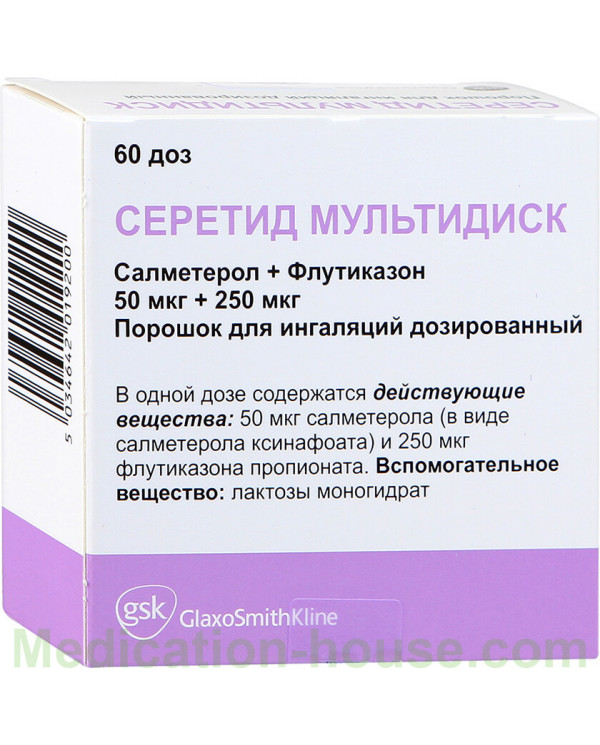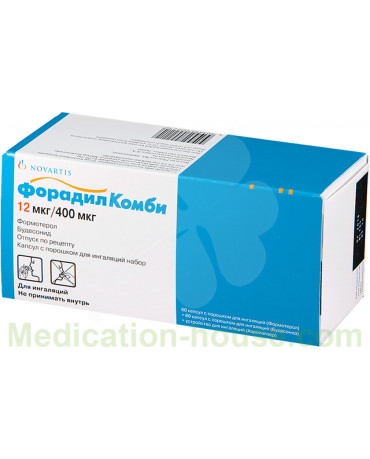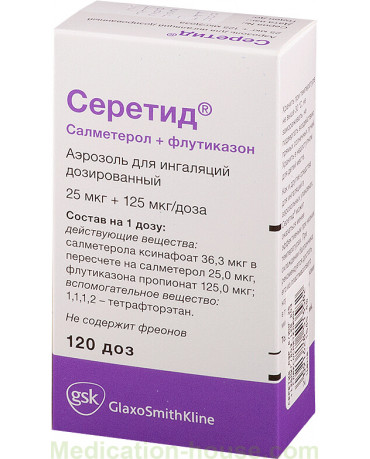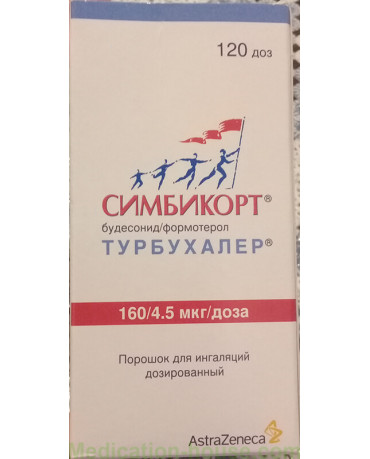Seretide Multidisc user manual
You can buy Seretide Multidisc here
Seretide Multidisc is a combined bronchodilating drug that includes selective beta2-adrenergic agonist and local glucocorticosteroid (GCS).
Release form and composition
Seretide Multidisc is available in the form of a powder for metered-dose inhalation: almost white or white (28 doses or 60 doses in aluminum blisters, the blister is placed in a plastic inhaler with a dose counter, 1 inhaler in a cardboard box and instructions for use of Seretide Multidisc).
1 dose contains:
active substances: salmeterol xinafoate micronized - 72.5 μg (equivalent to the content of 50 μg salmeterol) + fluticasone propionate micronized - 100, 250 or 500 μg;
auxiliary components: lactose monohydrate.
Pharmacodynamics
Seretide Multidisc is a combined drug that has a bronchodilator and anti-inflammatory effect. Its therapeutic effect is due to the content of two active components with different mechanisms of action. Salmeterol prevents the onset of symptoms of bronchospasm, fluticasone propionate prevents the exacerbation of the disease, improving pulmonary function. Therefore, the drug is a convenient alternative for patients who need to simultaneously take a beta2-adrenergic receptor agonist and inhaled GCS from different inhalers.
Salmeterol
Salmeterol is a selective long-acting beta2-adrenergic receptor agonist, the long side chain of which binds to the external domain of the receptor. Unlike short-acting beta2-adrenergic agonists, the pharmacological properties of salmeterol provide more effective protection against histamine-induced bronchoconstriction and prolonged (at least 12 hours) bronchodilation.
According to research, salmeterol is a potent inhibitor of the release of histamine, leukotrienes, prostaglandin D2 and other mast cell mediators from the human lungs with a prolonged period of action.
Salmeterol inhibits the early and late phase response to inhaled allergens. After the introduction of a single dose, the inhibition of the late phase of the response persists for 30 hours or more, the bronchodilating effect at this time is already absent. A single dose of salmeterol provides a weakening of the hyperreactivity of the bronchial tree.
Fluticasone propionate
Fluticasone propionate - GCS for local use, which has a pronounced anti-inflammatory and anti-allergic effect in the lungs. Its local activity helps to reduce clinical symptoms, reduce the frequency of exacerbations of bronchial asthma, without causing the undesirable effects that often accompany the use of systemic corticosteroids.
Prolonged use of inhaled fluticasone propionate in adults and children, even at the maximum recommended doses, does not cause a violation of the daily secretion of hormones of the adrenal cortex. After previous therapy with other inhaled corticosteroids, switching to fluticasone propionate leads to a gradual improvement in the daily secretion of hormones of the adrenal cortex, even against the background of periodic use of oral steroids. The reserve function of the adrenal cortex also remains within normal limits with long-term therapy with fluticasone propionate. Confirmation of this is a normal increase in cortisol production in response to appropriate stimulation. It should be borne in mind that a residual decrease in adrenal reserve after previous therapy may persist for a long time.
Pharmacokinetics
The combined inhalation use of salmeterol and fluticasone propionate does not have a clinically significant effect of the substances on the pharmacokinetics of each other. In this connection, the pharmacokinetic properties of each active component of the drug Seretide Multidisc can be considered separately.
Salmeterol
The local action of salmeterol in the lung tissue technically limits the availability of information about its pharmacokinetics. When inhaled in therapeutic doses, Cmax (maximum concentration) of the substance in the blood plasma is about 200 pg / ml and lower, therefore it cannot be an indicator of therapeutic effects. Against the background of regular inhalations in plasma, it is possible to detect hydroxynaphthoic acid at an equilibrium concentration (Css) of about 100 ng / ml, which is 1000 times less than the Css values observed in toxicity studies. In patients with airway obstruction, prolonged (more than a year) regular use of the drug did not cause adverse effects.
Extensive metabolism of salmeterol is carried out by aliphatic oxidation under the influence of the isoenzyme CYP3A4 of the cytochrome P450 system to alpha-hydroxysalmeterol.
There is no data on the distribution and excretion of salmeterol.
Fluticasone propionate
The absolute bioavailability of fluticasone propionate due to its administration with the Multidisc inhaler is 5.5%. In bronchial asthma and chronic obstructive pulmonary disease (COPD), the concentration of fluticasone propionate in blood plasma is lower. Systemic absorption of the substance occurs mainly through the lungs, the initial absorption rate is higher, but then it slows down.
The swallowed portion of the inhaled dose on the systemic absorption has a minimal effect due to the low solubility of fluticasone propionate in water and its presystem metabolism. Bioavailability from the gastrointestinal tract is less than 1%. The level of concentration of fluticasone propionate in the blood plasma is linear and increases with increasing inhalation dose.
The binding of fluticasone propionate to plasma proteins is 91%, Vd (distribution volume) in equilibrium is approximately 300 L.
The elimination of fluticasone propionate from the blood occurs rapidly. It is metabolized mainly by the action of the CYP3A4 isoenzyme of the cytochrome P450 system with the formation of an inactive carboxy metabolite. Care should be taken when using fluticasone propionate with known CYP3A4 inhibitors at the same time if this combination can cause an increase in plasma concentration of fluticasone propionate.
The final T1 / 2 (elimination half-life) is about 8 hours; the total clearance of fluticasone propionate from plasma is 1150 ml / min. The renal clearance of unchanged fluticasone propionate is less than 0.2%. In the form of a metabolite, it is excreted through the kidneys in an amount of 5% of the dose taken.
Indications for use
Seretide Multidisc is intended for regular use in patients with bronchial asthma who are shown combination therapy with long-acting beta2-adrenergic agonist and inhaled corticosteroid in the following cases:
it is necessary to provide adequate disease control during therapy with an inhaled corticosteroid and long-acting beta2-adrenergic agonist;
there is no sufficient control of the disease against the background of systematic monotherapy with inhaled corticosteroids and periodic use of short-acting beta2-adrenergic agonist;
starting maintenance therapy for persistent bronchial asthma is required in patients who are indicated for the appointment of corticosteroids to achieve disease control.
In addition, Seretide Multidisc is prescribed as maintenance therapy for patients with COPD with a forced expiratory volume in 1 second less than 60% of the norm (before inhalation of the bronchodilator), in the presence of repeated exacerbations in the anamnesis and the persistence of severe symptoms of the disease, despite the constant therapy with bronchodilators.
Contraindications
Absolute:
age up to 4 years;
hypersensitivity to the components of the drug.
With caution, Seretide Multidisc should be prescribed for acute or latent pulmonary tuberculosis, cardiovascular diseases (including arrhythmias: supraventricular tachycardia, extrasystole, ventricular extrasystole, atrial fibrillation), thyrotoxicosis, hypokalemia, and allergic reaction to lactosis, , cataracts, diabetes mellitus, fungal, viral or bacterial infections of the respiratory system.
The appointment of Seretide Multidisc during pregnancy and breastfeeding is allowed, but it should be done only in cases where the potential benefits of therapy for the mother outweigh the potential threat to the fetus and the baby.
Seretide Multidisc, instructions for use: method and dosage
The powder is intended for inhalation administration only.
The procedure is carried out using the "Multidisc" inhaler, which is equipped with an indicator that works in descending order. After each inhalation, the window shows the number of remaining doses. The red numbers on the indicator indicate that no more than 5 doses remain in the inhaler.
The inhaler should be kept closed.
To open the inhaler, you should cover its body with the fingers of one hand, and place the thumb of the other hand in a special depression and press it from you all the way and the sound of a click.
In the open state, the inhaler consists of a mouthpiece, a lever and a dose indicator.
Holding the inhaler with the mouthpiece to the face, in the direction away from yourself, press the lever all the way until a click sounds. At this moment, the next cell with the drug is opened, and a small hole with a ready dose of powder opens in the mouthpiece. Press the lever only before inhalation!
By placing the inhaler at a certain distance from the mouth, a deep, effortless exhalation is performed. Do not exhale into the inhaler! Grasping the mouthpiece tightly with your lips, you need to take a deep, even breath through your mouth, and then remove the mouthpiece from your mouth. After inhalation, breathing should be held for as long as possible (at least 10 seconds) and a slow exhalation should be made.
At the end of the procedure, the inhaler is closed by placing the thumb in a special recess and pushing it in the opposite direction until it stops (until a click sounds). The lever returns to its original position automatically. The inhaler is ready for use again.
Be sure to rinse your mouth with water after inhalation and spit it out.
The doctor should inform the patient that the optimal effect is achieved only with regular use of the drug, even if there are no clinical symptoms of asthma and COPD, and regularly evaluate the results of the therapy.
The dose and duration of the course of therapy is determined by the doctor.
For bronchial asthma, the lowest effective dose should be used.
If control over the symptoms is ensured by taking the drug 2 times a day, then as part of the dose reduction, you can use the frequency of procedures 1 time per day.
When prescribing Seretide Multidisc, the content of the dose of fluticasone propionate should correspond to the severity of the disease.
Recommended dosage for the combination of salmeterol and fluticasone propionate in the treatment of bronchial asthma:
children from 4 to 12 years: 1 inhalation in the amount of 50 mcg + 100 mcg (salmeterol + fluticasone propionate) 2 times a day;
patients aged 12 years and older: 1 inhalation in the amount of 50 mcg + 100 mcg (salmeterol + fluticasone propionate), 50 mcg + 250 mcg or 50 mcg + 500 mcg 2 times a day.
The maximum recommended dose for the treatment of chronic obstructive pulmonary disease in adult patients is one inhalation (50 μg salmeterol + 500 μg fluticasone propionate) 2 times a day.
In case of impaired renal and / or liver function, as well as treatment of elderly patients, dose adjustment is not required.
Side effects
Adverse reactions recorded during clinical trials:
from the respiratory system, chest and mediastinal organs: often - dysphonia and / or hoarseness of the voice; infrequently - pharyngeal irritation;
from the nervous system: very often - headache; infrequently - tremor;
mental disorders: infrequently - sleep disturbances, anxiety; rarely - hyperactivity, irritability and other changes in behavior (more often in children);
infections and parasitic diseases: often - candidiasis of the oral cavity and pharynx, in patients with COPD - pneumonia; rarely - candidiasis of the esophagus;
from the immune system: infrequently - shortness of breath, skin reactions of hypersensitivity; rarely anaphylactic reactions;
from the endocrine system: infrequently - cataract; rarely - glaucoma;
from the side of metabolism and nutrition: infrequently - hyperglycemia; very rarely - hypokalemia;
on the part of the heart: infrequently - palpitations, atrial fibrillation, tachycardia; rarely - arrhythmia (including supraventricular tachycardia, extrasystole, ventricular extrasystole);
from the musculoskeletal system and connective tissue: often - arthralgia, muscle spasms;
dermatological reactions: infrequently - bruising.
In addition, the following side effects were recorded in post-registration observations:
from the respiratory system, chest and mediastinal organs: rarely - paradoxical bronchospasm;
from the immune system: rarely - bronchospasm, angioedema (often swelling of the face and oropharynx);
from the endocrine system: rarely - cushingoid symptoms, Cushing's syndrome, inhibition of adrenal function, decreased bone mineral density, growth retardation in children and adolescents.
Overdose
symptoms: headache, tachycardia, tremor, increased systolic blood pressure (BP), hypokalemia. Against the background of an acute overdose of fluticasone with propionate, a temporary suppression of the hypothalamic-pituitary-adrenal system is possible in which the adrenal function is restored to normal within a few days and, as a rule, does not require any emergency measures. With prolonged use of high doses, a significant suppression of adrenal cortex function is possible. Acute adrenal crisis - usually occurs in children after prolonged therapy in high doses. It is manifested by hypoglycemia, seizures, confusion in stressful situations (trauma, infection, surgery or a sharp decrease in the dose of fluticasone propionate);
treatment: maintenance therapy, careful monitoring of the patient's condition. If an overdose occurs with prolonged use of high doses, it is recommended to monitor the reserve function of the adrenal cortex.
special instructions
Since Seretide Multidisc is not intended to alleviate the acute symptoms of the disease, patients should always have a short-acting inhaled bronchodilator with them for relief of such cases (for example, salbutamol).
The use of a combination of salmeterol and fluticasone propionate is indicated for use in the form of initial maintenance therapy for persistent bronchial asthma, if the patient takes a certain dose of corticosteroids to stop daily attacks.
If there is a paradoxical bronchospasm, manifested by an increase in shortness of breath immediately after inhalation, a short-acting inhaled bronchodilator should be immediately applied and the treatment should be replaced with alternative therapy.
When, in order to alleviate symptoms, it is increasingly necessary to resort to the use of short-acting bronchodilators, this indicates that the dose of the drug does not provide adequate control of the disease. The increasing and sudden deterioration in the control of bronchial asthma is associated with a potential threat to life, therefore it is necessary to consult a doctor to review the dosage regimen of corticosteroids.
Discontinue treatment with Seretide Multidisc should be done by gradually reducing the dose under the supervision of a physician. Abrupt withdrawal of the drug can cause an exacerbation of the disease.
Withdrawal of the drug in patients with COPD may be accompanied by symptoms of decompensation. In addition, it should be borne in mind that against the background of the combination of salmeterol and fluticasone propionate, exacerbation of COPD and the clinical picture of pneumonia are similar.
Long-term use in high doses of inhaled GCS can contribute to the development of undesirable effects of a systemic nature, therefore, for the treatment of bronchial asthma, it is necessary to use the lowest dose, which provides effective control of symptoms.
In stressful situations, it is necessary to consider the possibility of oppression of the adrenal glands and be prepared to receive GCS.
The degree of adrenal insufficiency must be determined during surgical interventions or resuscitation.
Long-term use of the drug in children should be accompanied by regular measurements of the growth of the child.
With extreme caution, they switch from taking oral GCS to inhaled therapy with fluticasone propionate. It is recommended that you regularly monitor the function of the adrenal cortex, because of the risk of adrenal suppression.
Previous therapy with systemic corticosteroids can suppress the manifestations of allergic rhinitis, eczema and other allergic reactions, therefore, after switching to inhalation therapy, their symptoms can be severe. For the treatment of such pathologies, it is recommended to symptomatically use antihistamines and / or GCS for topical use.
You can not abruptly stop taking systemic corticosteroids with the appointment of inhaled fluticasone propionate. Patients should always have a special patient card with them, indicating the need for additional administration of GCS in stressful situations.
With exacerbation of bronchial asthma and hypoxia, it is necessary to control the content of potassium ions in the plasma.
The drug can affect the level of glucose in the blood, contributing to its increase, therefore, patients with diabetes should be careful.
Side effects such as tremors, palpitations and headaches are short-lived, and with regular therapy their severity decreases.
Influence on the ability to drive vehicles and complex mechanisms
Inhalation of Seretide Multidisc does not affect the ability to drive vehicles and complex mechanisms. But during the treatment period, patients should consider the possibility of developing side effects of the drug and be careful.
Pregnancy and lactation
Due to the limited information on the use of the drug during gestation and lactation, the appointment of Seretide Multidisc during pregnancy and breastfeeding should be done only in cases where the potential benefits of therapy for the mother outweigh the possible threat to the fetus and child.
The effect of the drug on fertility in humans has not been established.
Use in childhood
It is contraindicated to prescribe Seretide Multidisc to children under the age of 4 years.
Long-term use of inhaled GCS should be accompanied by regular monitoring of the growth dynamics of the child.
With impaired renal function
In patients with impaired renal function, a dose reduction is not required.
With impaired liver function
Patients with impaired liver function dose reduction is not required.
Use in old age
For the treatment of elderly patients, a general dosage regimen is used.
Drug interaction
The simultaneous use of beta-blockers (selective and non-selective) increases the risk of developing bronchospasm, so their use should be avoided, except in cases of emergency.
Inhalation of fluticasone propionate is accompanied by its low plasma concentration, therefore its clinically significant interaction is unlikely.
Ritonavir, being a highly active inhibitor of the CYP3A4 isoenzyme, is able to cause a sharp increase in the level of fluticasone propionate, resulting in a significant decrease in the concentration of serum cortisol. Due to the high risk of systemic effects of corticosteroids, a combination of fluticasone propionate and ritonavir should be avoided, unless the expected therapeutic effect exceeds the risk of adverse events (Cushing's syndrome, suppression of adrenal function).
Caution is advised when prescribing strong CYP3A4 inhibitors (including ketoconazole), since this can cause a significant increase in the concentration of fluticasone propionate and salmeterol in the blood plasma and increase the risk of systemic effects of fluticasone propionate and prolongation of the QTc interval.
Concomitant therapy with corticosteroids, xanthine derivatives and diuretics during the use of Seretide Multidisc increases the risk of hypokalemia.
MAO inhibitors (monoamine oxidases) and tricyclic antidepressants can cause side effects from the cardiovascular system.
The simultaneous use of the drug with cromoglicic acid does not cause negative consequences.
Terms and conditions of storage
Keep out of the reach of children.
Store at temperatures up to 30 ° C.
Shelf life is 2 years.
Reviews on Seretide Multidisc
Reviews about Seretide Multidisc are more often positive. The use of the drug helps many patients to control asthma, returns the ability to breathe and lead a full life. The advantages of the drug include its ability to block attacks and treat bronchial asthma. After a few weeks of treatment, the intervals between seizures are significantly reduced. Users note the convenience in using the inhaler and recommend that you rinse your mouth with water after inhalation.
Terms of sell
You don't need a prescription to buy Seretide Multidisc.




